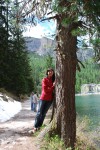Kim Martineau, science writer for The Earth Institute, became a journalist to discover the world, explore the human condition and reveal the truth hiding in a string of facts. As a newspaper writer for the Times Union in Albany, NY, and The Hartford Courant in Connecticut, she wrote about crime and punishment, small town government, higher education and the environment. She was twice named a finalist for the Livingston Awards for Young Journalists for profiling a transgender student at Yale and a Nobel Prize-winning chemist accused of stealing the rights to his own invention. A story that she broke about an antique map dealer caught slicing maps out of ancient books at a Yale library received national attention. She lives in New York City with her husband and a rabbit possibly old enough to qualify for the book of Guinness World Records.

The jury is still out on how tropical storms will change as climate warms, but rising sea levels will almost certainly place more coastal property at risk of flooding, says a team of scientists writing in the journal Nature.

Tourists flock to Italy to see Michelangelo’s David and other iconic hunks of Renaissance stone, but in a trip over spring break, a group of Columbia students got to visit rocks that have shaped the world in even more profound ways.

The Sahara wasn’t always a desert. Trees and grasslands dominated the landscape from roughly 10,000 to 5,000 years ago. Then, abruptly, the climate changed. A study by Lamont-Doherty’s Peter deMenocal says it took just a few hundred years to happen.

A massive landslide in Alaska’s snowy Wrangell-St. Elias mountain range in July may have been caused by a summer heat wave making some slopes more vulnerable to collapse, says the Lamont-Doherty scientist who first discovered the avalanche.

Earth Institute experts weigh in as the one-year anniversary of Hurricane Sandy approaches.

In a new study in Nature, climate scientist Maureen Raymo and her colleagues show that variations in sunlight interact with Earth’s topography and the size of ice sheets to control Earth’s ice ages on 100,000 year cycles. One important finding: as ice sheets grow bigger, they also become more vulnerable to melting.

Twice humans have witnessed the wasting of snow and ice from Peru’s tallest volcano, Nevado Coropuna—In the waning of the last ice age, some 12,000 years ago, and today, as industrial carbon dioxide in the air raises temperatures again. As in the past, Coropuna’s retreating glaciers figure prominently in the lives of people below. In an ongoing project, scientists at Columba University’s Lamont-Doherty Earth Observatory and partner institutions are reconstructing the ebb and flow of ice on Coropuna since the last ice age to understand how the tropics influence the global climate system, how ice-loss and a warmer climate will impact farming in the region, and what adaptation measures might help people survive in this hotter, drier world.

Lamont-Doherty scientist Hugh Ducklow is featured in a documentary due out next summer on climate change and the West Antarctic Peninsula. Catch a preview in this newly-released trailer.

The scientific publisher Elsevier and a data archiving facility at Columbia University’s Lamont-Doherty Earth Observatory are offering $5,000 and a trophy to the person with the best example of how data-preservation techniques are being used to advance new discoveries in the earth sciences.

A video profile of the Lamont-Doherty Core Repository—the world’s largest collection of deep sea sediments, some as old as 100 million years. The 19,000 cores, largely collected by Lamont’s own research vessels, are a central resource for the global scientific community, which uses them for studies of earth’s past and current environment, especially in regard to climate change.











